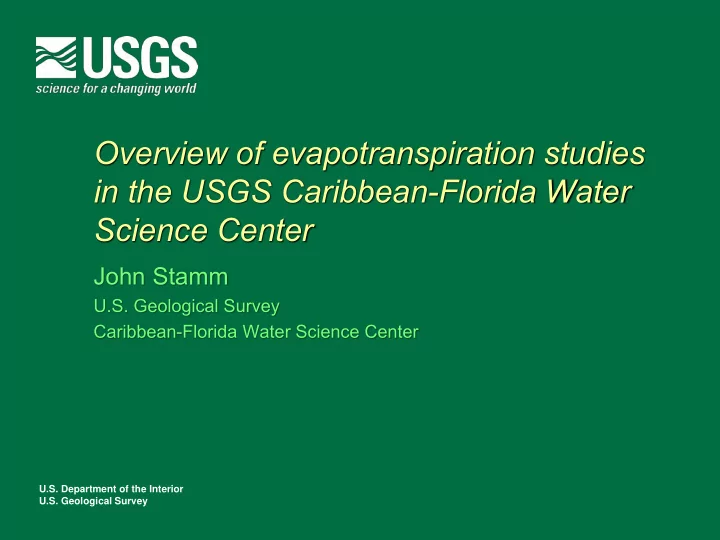

Overview of evapotranspiration studies in the USGS Caribbean-Florida Water Science Center John Stamm U.S. Geological Survey Caribbean-Florida Water Science Center U.S. Department of the Interior U.S. Geological Survey
Outline Contributing researchers Climate setting for Florida USGS ET stations Gridded ET products applications MODIS actual ET Future work
Contributing researchers USGS David Sumner, Ph.D., Associate Director for Studies, CFWSC Barclay Shoemaker, Ph.D., Research Hydrologist, CFWSC Michael Wacker, Hydrologist, CFWSC Academia John Mecikalski, Associate Professor, University of Alabama in Huntsville Johnna Infanti, Ph.D., University of Miami, University Cooperation for Atmospheric Research (UCAR) Cooperative Programs for the Advancement of Earth System Science, Postdoctoral Researcher Gabriel Senay, Ph.D., USGS Earth Resource Observation and Science (EROS) Center and Colorado State University
Climate setting for Florida Historical climate: 1961–2016 Projected climate to 2099
Historical climate Parameter-elevation Regressions on Independent Slopes Model Oregon State University Interpolates weather station data to a gridded dataset conterminous United States monthly mean of daily T min and T max monthly P 1895–present 2.5 minute resolution (~4.0x4.5 km in Florida)
Projected climate Community Climate System Model National Center for Atmospheric Research (NCAR), Boulder, CO CCSM3: 1.4 ⁰ lon and lat resolution (~140 by 155 km in Florida) A2 emission scenario CCSM4: 1.25 ⁰ lon by 0.9 ⁰ lat resolution (~125 by 100 km in Florida) RCP8.5 emission scenario
Effect of evapotranspiration on temperature?
Evapotranspiration is an important variable for validation of climate models, and for selection of “best” climate models for Florida studies.
USGS ET Stations Barclay Shoemaker, Michael Wacker, David Sumner Variety of land types and water settings Starkey Park, meadow, near Tampa Dead River, forested wetland, near Tampa
USGS CFWSC ET Network- Past & Present Blue Springs IFAS pasture Lake Wales Reedy Lake Tiger Bay Ferris Farms UCF urban L. Panasoffkee Duda Farms Starkey Indian River Lagoon L. Calm Disney Preserve L. Starr Dead River Blue Cypress Decommissioned 2X4 citrus Lake Okeechobee Operating Immokalee Loxahatchee Marsh WCA-3A Big Cypress Preserve Miami (3 sites) urban Wet Prairie Everglades (12 sites)
https://sofia.usgs.gov/exchange/evapotrans/
Gridded RET and PET products Barclay Shoemaker, John Mecikalski Reference and Potential Evapotranspiration: 2 kilometer resolution for Florida Identical to NEXRAD gridded precipitation dataset daily Geostationary Operational Environmental Satellite (GOES) estimates of solar insolation Atmospheric variables interpolated from weather station data
2015 Statewide GOES ET maps Alb T min RH max T max RH min W s Rn Priestley-Taylor (1972) PET / Allen et al. (1998) RET (standardized PM) PET / RET .com http://fl.water.usgs.gov/et/
http://fl.water.usgs.gov/et/
Current research / improvements Estimates of albedo using MODIS data Interpolation of atmospheric variables using radial basis function distance-squared interpolation currently used RBF increases weights of distant points when computing weights for interpolation Atmospheric data from the North American Regional Reanalysis Atmospheric data from the Weather Research and Forecasting Model
North American Regional Reanalysis 32 km spatial resolution 3 hour time step Full suite of atmospheric variables
Weather Research and Forecasting Model 2 km spatial resolution 1 hour time step Grid overlaps with PET, RET, NEXRAD grids Full suite of atmospheric variables WRF simulation at 2-km grid spacing for Florida Maximum Relative Humidity March 10, 2016
Research applications of ET data Calibration of simple estimators of evapotranspiration Water budget for Tsala Apopka system of lakes
Actual ET from USGS PET gridded product, calibrated to Actual ET from Starkey station station actual ET
Research applications of ET data Calibration of simple estimators of evapotranspiration Water budget for Tsala Apopka system of lakes
USGS RET grid for Tsala Apopka area
Percent of landuse type in each RET gridcell
Percent of landuse type in each RET gridcell AET /RET ratio for each landuse computed from station data AET computed for gridcell as function of RET multiplied by AET/RET ratios
Other USGS resources Gabriel Senay, USGS Fort Collins Operational Simplified Surface Energy Balance (SSEBop) Moderate Resolution Imaging Spectrometer (MODIS) Monthly actual ET (ETa) 1-km grid, global urban settings, over water Alternative to MOD16
https://earlywarning.usgs.gov/useta https://earlywarning.usgs.gov/useta
Future research Effects of hurricanes on evapotranspiration and carbon flux Loss of leaf area Calibration and validation of MODIS ETa for Florida Meeting in Orlando on October 19 th to discuss future research
Recommend
More recommend